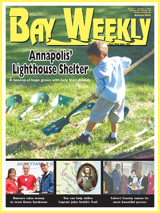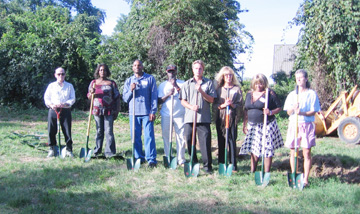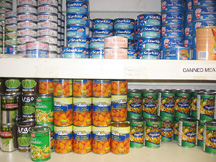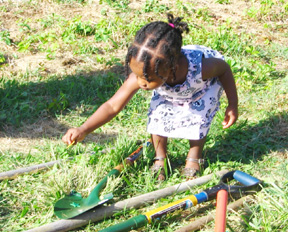
Volume XVII, Issue 40 # October 1 - October 8, 2009
|
 |
A Beacon of Hope Shining through Dark Times
In the midst of the nation’s financial crisis, Annapolis’ Light House Shelter is not only surviving but expanding
|
|
by Simone Gorrindo
The bell at the front door of the Light House Shelter jingles as a man steps inside. In the noon light, his shoulder-length grey hair shines below a frayed baseball cap. “You’re not serving lunch today?” he asks.
“They’re passing it out around the corner,” says the slight receptionist, springing up from her desk to direct him back outside. “Didn’t you see the sign?”
Beth Riedel is one of the many Anne Arundel volunteers whose help makes it possible for the Light House Shelter to hand out bagged lunches 365 days a year. Spending every Monday, Wednesday, Friday and Saturday at the front desk, she devotes so many hours to the shelter it’s practically a full-time job. “I do whatever they need me to,” she says before picking up a ringing phone. At Riedel’s desk, a client rifles through papers looking for her resume, which should have arrived by fax.
Not simply a soup kitchen or shelter, Annapolis’ Light House is an impressive support center for the community, offering services in many forms: homeless prevention, transitional housing, job training and parenting. Yet its modest location, an unmarked brick storefront on West Street, is strangely invisible. In fact, you can frequent Annapolis’ downtown sidewalks without ever noticing it.
Conversely, some people living in the shelter hold visible jobs in the city: “You may see them behind the counter at Dunkin’ Donuts every day,” explains Marilyn Baker, the Light House’s development director.
|
|
![]() The shelter’s interior matches its humble facade. The walls of the front room where Riedel greets guests are baby blue and scuffed. The rough, industrial carpet could have been used, well used, in an elementary classroom.
The shelter’s interior matches its humble facade. The walls of the front room where Riedel greets guests are baby blue and scuffed. The rough, industrial carpet could have been used, well used, in an elementary classroom.
Behind this reception area is the emergency shelter. The 18 beds, five for women and 13 for men, are covered in handmade patchwork quilts. On the second floor are two apartments for families. A calendar on a dry-erase board lists A.A. meetings and job seminars. The space looks and feels like most places that run on volunteer help and government funding: a little shabby and mismatched, yet bright with the efforts of those who work to keep it alive.
At noon, the beds are empty. Every weekday, guests must leave before 9am to attend or search out work. They are also required to be drug- and alcohol-free, a policy the shelter strictly enforces. Over their stay, which may last up to 90 days, some residents bond like tight-knit families, while others remain solitary. “Most women here are escaping domestic violence,” Baker says. “The ones who are really suffering tend to remain distant.”
In the hall beyond the beds is the stainless steel kitchen, where seven evenings a week local churches, families or other volunteers cook dinner for the guests. “We never serve anything we wouldn’t eat ourselves,” Baker says, pointing to the expiration date on a carton of milk in the stocked fridge. The food pantry at the end of the corridor is continually emptying, refilling with the help of donations. “We are out of so much right now,” Baker sighs, surveying the shelves: “tomato sauce; soup; we have peanut butter but no jelly.”
Baker is like a mother scanning her cupboards, though she carries more in her strained expression than maternal concern. The shelter is caring not for a single household but for an entire community. And food is just one aspect of what the center does for the needy: 75 percent of the people served by the Light House leave empowered — with a job or income, a place to live and the possibility of independence.
So in the midst of the nation’s financial crisis, is the Light House Shelter managing to survive? Yes: survive and even expand.
Hard Times
“I could tell you a long story that would make you cry,” says the man called Pops around the Light House.
He carries a stack of boxes on his shoulder. Born in Baltimore, Pops, 55, lived and worked in Annapolis for much of his adult life before he fell on hard times and made the woods his home for a year and a half. The Light House has helped him get back on his feet. He now has a basement apartment of his own and serves as the shelter’s custodian. “He proved himself,” Baker says proudly. “Everyone got a crush on him immediately.”
|
|
![]() Not everyone has been as fortunate as Pops. Last year, the Light House turned away 500 homeless people, 149 of them children. There simply was no room. Since the economic collapse, the center has also seen a wider demographic in need of homeless-prevention services. Some mornings the sidewalk outside the shelter is lined with people seeking help with bills.
Not everyone has been as fortunate as Pops. Last year, the Light House turned away 500 homeless people, 149 of them children. There simply was no room. Since the economic collapse, the center has also seen a wider demographic in need of homeless-prevention services. Some mornings the sidewalk outside the shelter is lined with people seeking help with bills.
“Traditionally, we serve low-income people,” says executive director Harry Cole. “But we are seeing policemen and electricians come in, asking for help with rent and BGE.” One client who made $500,000 the previous year showed up in need of aid.
In one of Maryland’s wealthiest counties, in the state’s manicured capitol, the often hidden population of the struggling and displaced is rising. Off Clay Street, a low-income neighborhood in downtown Annapolis, crumbling housing projects are being demolished with the plan of redevelopment. Some residents are promised a home again, but others have been banned from returning. “These people have already come to use our homeless-prevention services,” Cole says. “I expect more will show up at our doorstep.”
Despite Federal Reserve Chairman Ben Bernanke’s claim that, from a technical perspective, the national crisis is “very likely over at this point,” the symptoms of a weak economy will not disappear overnight. In this climate, non-profits like the Light House are lifelines, a last beacon of hope in a world that has left many high and dry.
As need peaks, non-profits themselves are hanging by a thread, and some have been forced to close. Chuck Bean, the executive director of Nonprofit Roundtable of Greater Washington, estimates that one in every 10 D.C. area non-profits is near collapse. Why? More people than ever need help.
Raising the Bar
It’s a heartbreaking cycle. Yet the Light House offers a story that throws a wrench in its course. The center managed to raise $2.5 million to buy the land for its expansion, a 24,000 square-foot, green-built homelessness-prevention and -support center triple the size of its current location. With 45 beds, five apartments for homeless families and 20 suites for newborn babies, the new shelter on Hudson Street will be the largest public and private collaboration for a social services project in the history of Anne Arundel County.
The shelter will feature a day center for the chronically homeless, people stuck on the streets due to mental illness or drug addiction. Among other amenities will be a computer lab, playground, library and teaching kitchen for culinary job training and nutritional education.
Over $6 million has been raised so far to build and furnish this ambitious new effort. By July 2010, the Light House board has committed to raise the $1.4 million needed to finish the building.
|
|
![]() To top off these industrious plans, the Light House is going green. Builders drew their inspiration to tread lightly from the people living in the shelter. “We can learn a lot from them,” says green building consultant Janet Harrison. “They’re some of the most resourceful non-wasters around.”
To top off these industrious plans, the Light House is going green. Builders drew their inspiration to tread lightly from the people living in the shelter. “We can learn a lot from them,” says green building consultant Janet Harrison. “They’re some of the most resourceful non-wasters around.”
Harrison aimed for LEED’s second lowest certification, Silver. “We’re focusing on the basic things that really need doing,” she says. She’s concentrating her effort in the energy area, cutting back use by 40 percent with such technologies as a ground-source heat pump, occupancy sensor lighting and light-colored roofing to reflect solar heat. “This will reduce their operating costs for years to come,” Harrison says.
How has the Light House managed such a visionary feat?
Local government is carrying some of the load. The city of Annapolis is contributing $600,000 toward the new space, a huge commitment for a small town. The county has put $250,000 toward the project.
Annapolis alderman Sam Shropshire rallied support, appealing to the city’s conscience: “Any city that can have $3 billion in yachts sitting in the harbor can afford to fund a new homeless shelter,” he said.
At the state level, Speaker of the House Michael Busch has put his weight behind the Campaign for Shelter as its honorary chairman, sponsoring bond bills amounting to $622,000 over the last three years. Not a single delegate opposed any of the Light House’s bills.
Joseph Gill, project director of the campaign committee, presented a budget that Busch calls “a moral document that reflects how we treat each other.” The state, Busch says, is determined to help in every way it can:
On the senate side, Sen. John Astle stood up for the shelter, which is in his district. “We went digging for whatever the state has to offer this organization,” Astle says.
Private businesses, donors, and foundations have also responded to the rally cry with donations big and small. The Marion I. and Henry J. Knott Foundation awarded the Light House $35,000 for pre-construction costs. This summer, Verizon contributed a $10,000 grant to expand a program designed to counsel and educate men with a history of violence toward women. Even kids pitch in. Last winter nine-year-old Liam Edem chose to forgo birthday presents and collected $250 in donations for the shelter instead.
“We have so many people whose hearts lie in the same place as mine,” says Elizabeth Kinney, chairwoman of the capital campaign.
Volunteers continue to be the bedrock of the shelter. For 20 years, the Light House has been crowded with creative and generous people eager to put their talents to good use.
|
|
![]() Chris Stelzig, an avid Annapolis cyclist, started the annual fundraiser Ride for Shelter five years ago. “We needed a cycling event in this town,” Stelzig says. “It’s been a great way to get our name out, raise some money and bring the community together all at the same time.” This year, the non-profit Friends of the Light House raised $15,000 with the event. In total, Friends has pledged $25,000 to the new shelter over the last four years.
Chris Stelzig, an avid Annapolis cyclist, started the annual fundraiser Ride for Shelter five years ago. “We needed a cycling event in this town,” Stelzig says. “It’s been a great way to get our name out, raise some money and bring the community together all at the same time.” This year, the non-profit Friends of the Light House raised $15,000 with the event. In total, Friends has pledged $25,000 to the new shelter over the last four years.
The new shelter’s 45 twin beds will be homier thanks to Leanne Tirpak’s Quilting Committee. Piecing quilts is an inexpensive way for the community not only to get involved but also to work together, Tirpak says, “in a communal tradition hundreds of years old.”
Meanwhile, volunteers and churches continue to work tirelessly for the current shelter on West Street, where people still need a roof and a hot meal; hungry families count on grocery handouts; and struggling substance abusers seek guidance.
St. Anne’s Parish — where Light House’s efforts began 20 years ago with six cots crowded into the church’s lobby — supplied groceries to hand out to the needy for the entire month of September. The Rev. James Packett, senior pastor of Chesapeake Christian Fellowship, has organized weekly Bible studies at the Light House. His church comes in every other Tuesday to serve hot dinners. “We don’t want to judge,” says Packett. “We just want to reach out.”
Joyce Nay, clinical social worker, volunteers therapy for those at the shelter, becoming for many a spiritual guide. “She has the biggest heart of anyone I know,” says one man Nay helped stay sober after he knocked at the Light House’s door.
In a vulnerable and changing world, volunteers like Nay have helped the Light House to live up to the purpose behind its name: to navigate those lost in the storm back to safety.
Our Common Humanity
“A lot of people like to say this is a stingy county,” Elizabeth Kinney says, choking up. A crowd has gathered in an unfinished room at the high-scale Annapolis Towne Centre for a reception celebrating the new shelter’s groundbreaking. “But if you educate and inspire, this is the most generous community I have ever seen.” She has tears in her eyes, but a defiant smile on her face.
Fierce passion moves many of the volunteers to come to the Light House’s aid. “I think it’s their people,” explains Renee Tilton of Crosby Marketing of why she’s glad to work for the shelter’s campaign. “You can prepare a speech and memorize it. But you can’t fake that emotion.”
Others are impressed by the Light House’s commitment to making the people who pass through its doors feel that they are valuable and belonging participants of the community. “They give them such dignity,” Tirpak says. “They expect things of them.”
A handsome man with broad shoulders and thick blond hair takes the microphone as Kinney moves to the side. “Many of you may have passed over me,” he says, looking out at the crowd with dauntless blue eyes. “After 31 years of substance abuse, I was living under the Severn Bridge. I knew I had hit bottom.”
The room is silent. A few people fidget uncomfortably. “It can happen to anyone.” Delivered at this moment by the unwavering voice at the microphone, the stock phrase resonates.
When Kinney began serving hot dinners for the Light House 18 years ago, she brought her fourth grade daughter along. The girl was scared of the homeless people, afraid to get near them. But as she was serving one man, she was struck by recognition: His hand, it’s just like my father’s.
Ultimately, it may be what Light House director Cole calls our “common humanity” that draws volunteers to the shelter.




